List of sultans of the Ottoman Empire
| Sultan of the Ottoman Empire | |
|---|---|
| Osmanlı padişahı | |
Imperial | |
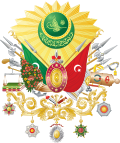 | |
 | |
| Details | |
| Style | 1 November 1922 |
| Residence | Palaces in Istanbul:
|
| Appointer | Hereditary |



The
The
Names
The sultan was also referred to as the
Names of the sultan in languages used by ethnic minorities:[4]
- Ottoman Constitution of 1876 instead used direct translations of "sultan" (Sultan) and "padishah" (Padišax)[4]
- Greek: In earlier periods the Greeks used the Byzantine Empire-style name "basileus". The translation of the Ottoman Constitution of 1876 instead used a direct transliterations of "sultan" (Σουλτάνος Soultanos) and "padishah" (ΠΑΔΙΣΑΧ padisach).[4]
- Judaeo-Spanish: Especially in older documents, El Rey ("the king") was used. In addition some Ladino documents used sultan (in Hebrew characters: שולטן and סולטן).[4]
State organisation of the Ottoman Empire
The Ottoman Empire was an
After the
Although absolute in theory and in principle, the sultan's powers were limited in practice. Political decisions had to take into account the opinions and attitudes of important members of the dynasty, the bureaucratic and military establishments, as well as religious leaders.
List of sultans

The table below lists Ottoman sultans, as well as the last Ottoman caliph, in chronological order. The
| No. | Sultan | Portrait | Reign | Tughra | Notes | Coinage |
|---|---|---|---|---|---|---|
| Rise of the Ottoman Empire (1299 – 1453) | ||||||
| 1 | Osman I | 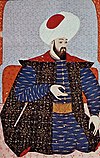
|
c. 1299 – c. 1324[19] (25 years~) |
—[c] |
|

|
| 2 | Orhan | 
|
c. 1324 – March 1362 (38 years~) |

|
|

|
| 3 | Murad I[b] | 
|
March 1362 – 15 June 1389 (27 years, 3 months) |

|
|

|
| 4 | Bayezid I | 
|
15 June 1389 – 20 July 1402 (13 years, 35 days) |

|
|

|
| Ottoman Interregnum[d] (20 July 1402 – 5 July 1413) | ||||||
| — | İsa Çelebi | 
|
January – March/May 1403 (3–5 months) |
— |
|
— |
| — | Süleyman Çelebi | 
|
20 July 1402 – 17 February 1411[22] (8 years, 212 days) |

|

| |
| — | Musa Çelebi | 
|
18 February 1411 – 5 July 1413[23] (2 years, 137 days) |
— |
|

|
| — | Mehmed Çelebi | 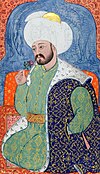
|
1403 – 5 July 1413 (10 years) |
— |
|

|
| Sultanate resumed | ||||||
| 5 | Mehmed I | 
|
5 July 1413 – 26 May 1421 (7 years, 325 days) |

|
|
— |
| — | Mustafa Çelebi | — | January 1419 – May 1422 (3 years, 4 months) |
— | 
| |
| 6 | Murad II | 
|
25 June 1421 – August 1444 (23 years, 2 months) |

|
|
 
|
| 7 | Mehmed II | 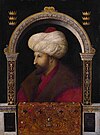
|
August 1444 – September 1446 (2 years, 1 month) |

|
|

|
| (6) | Murad II | 
|
September 1446 – 3 February 1451 (4 years, 5 months) |

|
— | |
Growth of the Ottoman Empire (1453–1550) | ||||||
| (7) | Mehmed II | 
|
3 February 1451 – 3 May 1481 (30 years, 89 days) |

|
|

|
| 8 | Bayezid II | 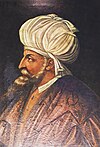
|
19 May 1481 – 25 April 1512 (30 years, 342 days) |

|
|

|
| — | Cem Sultan | 
|
28 May – 20 June 1481 (23 days) |

|
|

|
| 9 | Selim I | 
|
25 April 1512 – 21 September 1520 (8 years, 149 days) |
|

| |
| 10 | Suleiman I | 
|
30 September 1520 – 6 September 1566 (45 years, 341 days) |

|
|

|
| Transformation of the Ottoman Empire (1550–1700) | ||||||
| 11 | Selim II | 
|
29 September 1566 – 15 December 1574 (8 years, 77 days) |
|
 
| |
| 12 | Murad III | 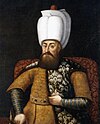
|
27 December 1574 – 16 January 1595 (20 years, 20 days) |

|
|

|
| 13 | Mehmed III | 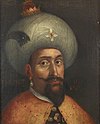
|
16 January 1595 – 22 December 1603 (8 years, 340 days) |

|
|

|
| 14 | Ahmed I | 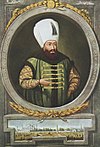
|
22 December 1603 – 22 November 1617 (13 years, 335 days) |

|
|

|
| 15 | Mustafa I | 
|
22 November 1617 – 26 February 1618 (96 days) |
|
— | |
| 16 | Osman II | 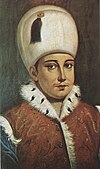
|
26 February 1618 – 19 May 1622 (4 years, 82 days) |
|

| |
| (15) | Mustafa I | 
|
20 May 1622 – 10 September 1623 (1 year, 113 days) |
— | ||
| 17 | Murad IV | 
|
10 September 1623 – 8 February 1640 (16 years, 151 days) |

|
|
— |
| 18 | Ibrahim | 
|
9 February 1640 – 8 August 1648 (8 years, 181 days) |

|
|
— |
| 19 | Mehmed IV | 
|
8 August 1648 – 8 November 1687 (39 years, 92 days) |

|
|
— |
| 20 | Suleiman II | 
|
8 November 1687 – 22 June 1691 (3 years, 226 days) |
|

| |
| 21 | Ahmed II | 
|
22 June 1691 – 6 February 1695 (3 years, 229 days) |

|
|
— |
| 22 | Mustafa II | 
|
6 February 1695 – 22 August 1703 (8 years, 197 days) |

|
|

|
Stagnation and reform of the Ottoman Empire (1700–1827) | ||||||
| 23 | Ahmed III | 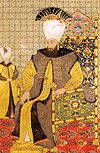
|
22 August 1703 – 1 October 1730 (27 years, 40 days) |

|
|

|
| 24 | Mahmud I | 
|
2 October 1730 – 13 December 1754 (24 years, 72 days) |

|
|

|
| 25 | Osman III | 
|
13 December 1754 – 30 October 1757 (2 years, 321 days) |
|

| |
| 26 | Mustafa III | 
|
30 October 1757 – 21 January 1774 (16 years, 83 days) |

|
|
 
|
| 27 | Abdul Hamid I | 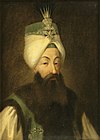
|
21 January 1774 – 7 April 1789 (15 years, 76 days) |

|
|

|
| 28 | Selim III | 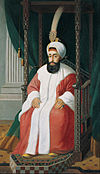
|
7 April 1789 – 29 May 1807 (18 years, 52 days) |

|
|

|
| 29 | Mustafa IV | 
|
29 May 1807 – 28 July 1808 (1 year, 60 days) |

|
|
— |
| Modernization of the Ottoman Empire (1827–1908) | ||||||
| 30 | Mahmud II | 
|
28 July 1808 – 1 July 1839 (30 years, 338 days) |

|
|
 
|
| 31 | Abdulmejid I | 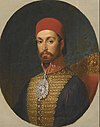
|
1 July 1839 – 25 June 1861 (21 years, 359 days) |

|
|
 
|
| 32 | Abdulaziz | 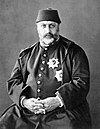
|
25 June 1861 – 30 May 1876 (14 years, 340 days) |

|
|
 
|
| 33 | Murad V | 
|
30 May – 31 August 1876 (93 days) |

|
|
— |
| 34 | Abdul Hamid II | 
|
31 August 1876 – 27 April 1909 (32 years, 239 days) |

|
|

|
| 35 | Mehmed V | 
|
27 April 1909 – 3 July 1918 (9 years, 67 days) |

|
|

|
| 36 | Mehmed VI | 
|
4 July 1918 – 1 November 1922 (4 years, 120 days) |

|

| |
| Caliph under the Grand National Assembly of Turkey (1 November 1922 – 3 March 1924) | ||||||
| — | Abdulmejid II | 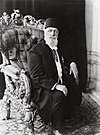
|
19 November 1922 – 3 March 1924 (1 year, 106 days) |
— [c] |
|
— |
See also
- Line of succession to the Ottoman throne
- Ottoman Sultan family tree
- Ottoman family tree (more detailed)
- List of valide sultans
- List of Ottoman grand viziers
- List of admirals in the Ottoman Empire
- List of Kapudan Pashas
Notes
- aRûm being an old Islamic name for the Roman Empire. The combining of the Islamic and Central Asian heritages of the Ottomans led to the adoption of the title that became the standard designation of the Ottoman ruler: Sultan [Name] Khan.[31] Ironically, although the title of sultan is most often associated in the Western world with the Ottomans, people within Turkey generally use the title of padishah far more frequently when referring to rulers of the Ottoman Dynasty.[32]
- b1876 Constitution (Article 4).[35]
- c1 2 : Tughras were used by 35 out of 36 Ottoman sultans, starting with Orhan in the 14th century, whose tughra has been found on two different documents. No tughra bearing the name of Osman I, the founder of the empire, has ever been discovered,[36] although a coin with the inscription "Osman bin Ertuğrul" has been identified.[20] Abdulmejid II, the last Ottoman Caliph, also lacked a tughra of his own, since he did not serve as head of state (that position being held by Mustafa Kemal, President of the newly founded Republic of Turkey) but as a religious and royal figurehead.
- d^ : The Ottoman Interregnum, also known as the Ottoman Triumvirate (Turkish: Fetret Devri), was a period of chaos in the Ottoman Empire which lasted from 1402 to 1413. It started following the defeat and capture of Bayezid I by the Turco-Mongol warlord Tamerlane at the Battle of Ankara, which was fought on 20 July 1402. Bayezid's sons fought each other for over a decade, until Mehmed I emerged as the undisputed victor in 1413.[37]
- e^ : The dissolution of the Ottoman Empire was a gradual process which started with the abolition of the sultanate and ended with that of the caliphate 16 months later. The sultanate was formally abolished on 1 November 1922. Sultan Mehmed VI fled to Malta on 17 November aboard the British warship Malaya. This event marked the end of the Ottoman Dynasty, not of the Ottoman State nor of the Ottoman Caliphate. On 19 November, the Grand National Assembly (TBMM) elected Mehmed VI's cousin Abdulmejid II, the then crown prince, as caliph.[38] The official end of the Ottoman State was declared through the Treaty of Lausanne (24 July 1923), which recognized the new "Ankara government," and not the old Istanbul-based Ottoman government, as representing the rightful owner and successor state. The Republic of Turkey was proclaimed by the TBMM on 29 October 1923, with Mustafa Kemal as its first President.[39] Although Abdulmejid II was a figurehead lacking any political power, he remained in his position of Caliph until the office of the Caliphate was abolished by the TBMM on 3 March 1924.[35] Mehmed VI later tried unsuccessfully to reinstall himself as caliph in the Hejaz.[40]
References
- ^ Stavrides 2001, p. 21
- ^ Kafadar 1995, p. 122. "That they hailed from the Kayı branch of the Oğuz confederacy seems to be a creative "rediscovery" in the genealogical concoction of the fifteenth century. It is missing not only in Ahmedi but also, and more importantly, in the Yahşi Fakih-Aşıkpaşazade narrative, which gives its own version of an elaborate genealogical family tree going back to Noah. If there was a particularly significant claim to Kayı lineage, it is hard to imagine that Yahşi Fakih would not have heard of it."
Lowry 2003, p. 78. "Based on these charters, all of which were drawn up between 1324 and 1360 (almost one hundred fifty years prior to the emergence of the Ottoman dynastic myth identifying them as members of the Kayı branch of the Oguz federation of Turkish tribes), we may posit that..."
Lindner 1983, p. 10. "In fact, no matter how one were to try, the sources simply do not allow the recovery of a family tree linking the antecedents of Osman to the Kayı of the Oğuz tribe. Without a proven genealogy, or even without evidence of sufficient care to produce a single genealogy to be presented to all the court chroniclers, there obviously could be no tribe; thus, the tribe was not a factor in early Ottoman history." - ^ Glazer 1996, "War of Independence"
- ^ a b c d e f Strauss 2010, pp. 21–51.
- OCLC 563022439.
- ^ a b Findley 2005, p. 115
- ^ a b Glazer 1996, "Ottoman Institutions"
- ^ Toynbee 1974, pp. 22–23
- ^ Stavrides 2001, p. 20
- ^ Quataert 2005, p. 93
- ^ d'Osman Han 2001, "Ottoman Padishah Succession"
- ^ Quataert 2005, p. 90
- ^ Peirce, Leslie. "The sultanate of women". Channel 4. Archived from the original on 2007-12-03. Retrieved 2009-04-18.
- ^ Glazer 1996, "External Threats and Internal Transformations"
- ^ "Last heir to Ottoman throne passes away at 90". Daily Sabah. 19 January 2021.
- ^ Quataert 2005, p. 91
- ^ Quataert 2005, p. 92
- ^ Karateke 2005, pp. 37–54
- ^ Finkel 2007, p. 33.
- ^ a b Kafadar 1995, pp. 60, 122.
- ^ a b c d e f g h Lowry 2003, p. 153.
- ^ a b Jorga 2009, p. 314.
- ^ a b von Hammer, pp. 58–60.
- ^ Prof. Yaşar Yüce-Prof. Ali Sevim: Türkiye tarihi Cilt II, AKDTYKTTK Yayınları, İstanbul, 1991 pp 74–75
- ^ Kafadar 1995, p. xix
- ^ Turkish Language Association, (1960), Belleten, p. 467 (in Turkish)
- ^ Ágoston, Gábor (2009). "Süleyman I". In Ágoston, Gábor; Masters, Bruce (eds.). Encyclopedia of the Ottoman Empire.
- ^ Aşiroğlu 1992, p. 13
- ^ Aşiroğlu 1992, p. 17
- ^ Aşiroğlu 1992, p. 14
- ^ Peirce 1993, pp. 158–159
- OCLC 6298914. Retrieved 2009-04-25.
- ^ Glassé 2003, pp. 349–351.
- ^ Quataert 2005, pp. 83–85
- ^ a b Toprak 1981, pp. 44–45
- ^ Mensiz, Ercan. "About Tugra". Tugra.org. Archived from the original on 2007-10-25. Retrieved 2009-02-06.
- ^ Sugar 1993, pp. 23–27
- ^ Aşiroğlu 1992, p. 54
- ^ Glazer 1996, "Table A. Chronology of Major Kemalist Reforms"
- OCLC 162287003. Retrieved 2009-05-02.
Bibliography
- Aşiroğlu, Orhan Gâzi (1992). Son halife, Abdülmecid. Tarihin şahitleri dizisi (in Turkish). Istanbul: Burak Yayınevi. OCLC 32085609.
- Findley, Carter V. (2005). The Turks in World History. New York: OCLC 54529318. Retrieved 2009-04-29.
- Finkel, Caroline (2007). Osman's Dream: The History of the Ottoman Empire. Basic Books. ISBN 978-0465008506.
- Glassé, Cyril, ed. (2003). "Ottomans". The New Encyclopedia of Islam. Walnut Creek, CA: AltaMira Press. OCLC 52611080. Retrieved 2009-05-02.
- Glazer, Steven A. (1996) [Research completed January 1995]. "Chapter 1: Historical Setting". In OCLC 33898522. Retrieved 2009-04-22.
- ISBN 975-6480-17-3.
- Kafadar, Cemal (1995). Between Two Worlds: The Construction of the Ottoman State. Berkeley, CA: OCLC 55849447. Retrieved 2009-04-18.
- Karateke, Hakan T. (2005). "Who is the Next Ottoman Sultan? Attempts to Change the Rule of Succession during the Nineteenth Century". In Weismann, Itzchak; Zachs, Fruma (eds.). Ottoman Reform and Muslim Regeneration: Studies in Honour of Butrus Abu-Manneb. London: I.B. Tauris. OCLC 60416792. Retrieved 2009-05-02.
- Lindner, Rudi Paul (1983). Nomads and Ottomans in Medieval Anatolia. Indiana University Press.
- Lowry, Heath (2003). The Nature of the Early Ottoman State. SUNY Press. ISBN 0-7914-5636-6.
- d'Osman Han, Nadine Sultana (2001). The Legacy of Sultan Abdulhamid II: Memoirs and Biography of Sultan Selim bin Hamid Han. Foreword by Manoutchehr M. Eskandari-Qajar. Santa Fe, NM: Sultana Pub. from the original on 2009-01-05. Retrieved 2009-05-02.
- OCLC 243767445. Retrieved 2009-04-19.
- Quataert, Donald (2005). The Ottoman Empire, 1700–1922 (2nd ed.). OCLC 59280221. Retrieved 2009-04-18.
- Stavrides, Theoharis (2001). The Sultan of Vezirs: The Life and Times of the Ottoman Grand Vezir Mahmud Pasha Angelović (1453–1474). Leiden: OCLC 46640850. Retrieved 2009-04-18.
- Strauss, Johann (2010). "A Constitution for a Multilingual Empire: Translations of the Kanun-ı Esasi and Other Official Texts into Minority Languages". In Herzog, Christoph; Malek Sharif (eds.). The First Ottoman Experiment in Democracy. Martin Luther University) // CITED: pp. 43–44 (PDF pp. 45–46/338).
- OCLC 34219399. Retrieved 2009-04-18.
- Toprak, Binnaz (1981). Islam and Political Development in Turkey. Leiden: Brill Publishers. OCLC 8258992. Retrieved 2009-04-19.
- OCLC 1318483. Retrieved 2009-05-02.
- Uğur, Ali (2007). Mavi Emperyalizm [Blue Imperialism] (in Turkish). Istanbul: Çatı Publishing. OCLC 221203375. Retrieved 2009-04-19.
- von Hammer, Joseph. Osmanlı Tarihi cilt I. condensed by Abdülkadir Karahan. Istanbul: Milliyet yayınları.
